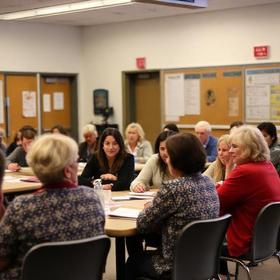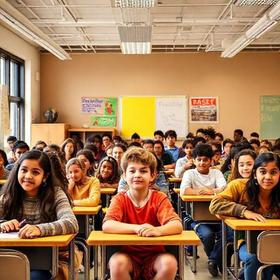Serving 301 students in grades Prekindergarten-5, James H. Harrison Elementary School ranks in the bottom 50% of all schools in Maryland for overall test scores (math proficiency is bottom 50%, and reading proficiency is bottom 50%).
The percentage of students achieving proficiency in math is 20-24% (which is lower than the Maryland state average of 27%). The percentage of students achieving proficiency in reading/language arts is 35-39% (which is lower than the Maryland state average of 45%).
The student-teacher ratio of 9:1 is lower than the Maryland state level of 14:1.
Minority enrollment is 97% of the student body (majority Hispanic), which is higher than the Maryland state average of 68% (majority Black and Hispanic).
Quick Facts (2025-26)
- Grades: Prekindergarten-5
- Enrollment: 301 students
- Student-Teacher Ratio: 9:1
- Minority Enrollment: 97%
- Overall Testing Rank: Bottom 50% in MD
- Math Proficiency: 20-24% (Btm 50%)
- Reading Proficiency: 35-39% (Btm 50%)
- Science Proficiency: 20-29% (Btm 50%)
- Source: National Center for Education Statistics (NCES), MD Dept. of Education
Top Rankings
James H. Harrison Elementary School ranks among the top 20% of public schools in Maryland for:
Category
Attribute
Most improved public schools
Community Size
Student Attention
School Overview
James H. Harrison Elementary School's student population of 301 students has declined by 7% over five school years.
The teacher population of 33 teachers has declined by 8% over five school years.
Grades Offered
Grades Prekindergarten-5
(Supplemental Virtual)
(Supplemental Virtual)
Total Students
301 students
Gender %
Total Classroom Teachers
33 teachers
School Calendar
School Mascot
Tigers
School Rankings
James H. Harrison Elementary School ranks within the bottom 50% of all 1,338 schools in Maryland (based off of combined math and reading proficiency testing data).
The diversity score of James H. Harrison Elementary School is 0.59, which is less than the diversity score at state average of 0.74. The school's diversity has stayed relatively flat over five school years.
Overall Testing Rank
#756 out of 1338 schools
(Bottom 50%)
(Bottom 50%)
Math Test Scores (% Proficient)
20-24%
27%
Reading/Language Arts Test Scores (% Proficient)
35-39%
45%
Science Test Scores (% Proficient)
20-29%
36%
Student-Teacher Ratio
9:1
14:1
American Indian
1%
n/a
Asian
4%
7%
Hispanic
54%
23%
Black
35%
33%
White
3%
32%
Hawaiian
n/a
n/a
Two or more races
3%
5%
All Ethnic Groups
Participates in the National School Lunch Program (NSLP)
Yes
Eligible for Free Lunch
71%
44%
Eligible for Reduced Lunch
10%
5%
School Statewide Testing
School District Name
Source: National Center for Education Statistics (NCES), MD Dept. of Education
School Notes
- School Mascot: Tigers
Profile last updated: 02/09/2025
Frequently Asked Questions
What is James H. Harrison Elementary School's ranking?
James H. Harrison Elementary School is ranked #756 out of 1,338 schools, which ranks it among the bottom 50% of public schools in Maryland.
What schools are James H. Harrison Elementary School often compared to?
James H. Harrison Elementary Schoolis often viewed alongside schools like Deerfield Run Elementary School, Oaklands Elementary School by visitors of our site.
What percent of students have achieved state testing proficiency in math and reading?
20-24% of students have achieved math proficiency (compared to the 27% MD state average), while 35-39% of students have achieved reading proficiency (compared to the 45% MD state average).
How many students attend James H. Harrison Elementary School?
301 students attend James H. Harrison Elementary School.
What is the racial composition of the student body?
54% of James H. Harrison Elementary School students are Hispanic, 35% of students are Black, 4% of students are Asian, 3% of students are White, 3% of students are Two or more races, and 1% of students are American Indian.
What is the student-teacher ratio of James H. Harrison Elementary School?
James H. Harrison Elementary School has a student ration of 9:1, which is lower than the Maryland state average of 14:1.
What grades does James H. Harrison Elementary School offer ?
James H. Harrison Elementary School offers enrollment in grades Prekindergarten-5 (Supplemental Virtual).
What school district is James H. Harrison Elementary School part of?
James H. Harrison Elementary School is part of Prince George's County Public Schools.
School Reviews
Review James H. Harrison Elementary School. Reviews should be a few sentences in length. Please include any comments on:
- Quality of academic programs, teachers, and facilities
- Availability of music, art, sports and other extracurricular activities
Recent Articles

Parental Involvement and Public School Outcomes
How parental involvement shapes public school outcomes, achievement, and school climate with 2025 insights.

Adult Education and Community Programs in Public Schools
Learn how public schools provide adult education and community programs that expand career skills, literacy, and workforce readiness across local communities.

Public vs Private Schools in the U.S. — 2025 Guide
A clear, up-to-date 2025 comparison of U.S. public vs private schools: costs, enrollment, policy trends, and what families should know today.





